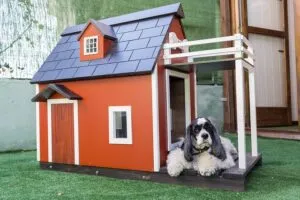Heated dog houses offer pets comfort and safety during cold weather, featuring insulated structures and certified heating elements. With various designs catering to different climates and needs, these shelters range from basic models to complex options with adjustable settings and eco-friendly technologies. Proper installation, regular cleaning, and energy-efficient heating are key to maintaining a warm and secure environment for furry friends year-round.
As dog owners, ensuring your furry companions’ comfort and safety is paramount, especially during harsh weather. While natural insulation helps, heated dog houses offer an excellent solution for keeping dogs warm in cold climates. This comprehensive guide explores what these innovative shelters are, how they work, and why they’re beneficial. We’ll cover types, selection tips, installation, maintenance, and safety considerations for these game-changing additions to any pet owner’s arsenal.
- What are Heated Dog Houses?
- How Do Heated Dog Houses Work?
- Benefits of Heated Dog Houses
- Types of Heated Dog Houses
- Choosing the Right Heated Dog House for Your Pet
- Installation and Maintenance Tips
- Safety Considerations for Heated Dog Houses
What are Heated Dog Houses?

Heated dog houses are specifically designed outdoor shelters equipped with built-in heating systems to provide warmth and comfort for dogs during cold weather. These structures come in a variety of styles, ranging from simple, basic models to more complex, indoor and outdoor options that mimic home environments. Independent of their design, the primary function of a heated dog house is to create a safe haven where dogs can retreat from harsh conditions, ensuring they remain cozy and healthy throughout the winter months.
The insulation in these dog houses plays a crucial role in retained heat, acting as a barrier between the interior space and external temperatures. This feature ensures that the warmth generated by the heating system stays inside, creating an ideal environment for dogs to rest and play without the chill of the outdoors. Whether you live in a snowy region or simply want to offer your furry friend a comfortable outdoor space year-round, heated dog houses provide a practical solution, offering both safety and comfort for pets.
How Do Heated Dog Houses Work?

Heated dog houses provide a cozy sanctuary for our furry companions during chilly weather. These innovative structures utilize various heating mechanisms to maintain optimal warmth, ensuring dogs stay comfortable even in freezing temperatures. Typically, heated dog houses incorporate either electrical heating pads or eco-friendly alternatives like solar panels and thermal insulation.
Electrical models feature built-in heaters that distribute heat evenly throughout the house, while solar-powered options capture sunlight during the day and retain heat at night. The weatherproof design of these dog houses prevents cold air from entering and maintains a consistent temperature, making them ideal for pet owners in colder climates who want to offer their dogs warmth in cold climates. Additionally, many models come with adjustable settings, allowing owners to customize the level of warmth according to their dog’s preferences. Choosing an eco-friendly heating choice not only benefits the environment but can also be more cost-effective in the long run for responsible pet parents.
Benefits of Heated Dog Houses

Heated dog houses offer a range of benefits that ensure your furry friend stays warm and comfortable year-round, especially in colder climates. One of the primary advantages is their ability to mimic a natural environment, providing a cozy space that feels like home for dogs. These houses are designed with insulation and safety-certified heating elements that maintain optimal temperatures, keeping your dog’s fur dry and healthy.
Additionally, heated dog houses promote better sleep patterns for your pets, as they can rest soundly without the discomfort of cold floors or walls. The energy-efficient heating systems used in these houses not only reduce utility costs but also contribute to a more sustainable environment. Moreover, many models feature thermostat control, allowing you to set and maintain desired temperatures, ensuring your dog stays warm during colder months and cool during warmer seasons.
Types of Heated Dog Houses

Heated dog houses come in various types, each designed to cater to different needs and preferences. One common category is the weatherproof design models, which are built to withstand harsh weather conditions, ensuring your pet stays safe and dry both indoors and out. These structures often feature durable materials like plastic, metal, or sturdy wood, along with sealed seams and waterproof coatings to prevent water penetration.
Another notable type incorporates safety-certified heating elements, guaranteeing a warm and secure environment without compromising safety. These heated dog houses come equipped with advanced heating systems that maintain consistent temperatures, typically featuring thermostats for user control. Built-in heating systems are designed to be energy-efficient while providing ample warmth, making them an ideal choice for pet owners looking to save on utility bills while keeping their furry friends cozy.
Choosing the Right Heated Dog House for Your Pet

Selecting the perfect heated dog house involves considering your pet’s unique needs and your specific living environment. When choosing an option that suits both your furry friend and your climate, it’s essential to think about whether you require an indoor & outdoor solution. Some dogs thrive in enclosed spaces with consistent warmth, while others may prefer a more open-air design. Regardless of the choice, ensure the dog house is insulated for retained heat, allowing your pet to stay cozy even during sudden temperature drops.
The location also plays a pivotal role. If you live in an area prone to harsh winters, investing in a heated dog house that provides warmth in cold climates is crucial. Look for features like temperature control and energy-efficient heating elements. Remember, the right heated dog house should offer comfort, durability, and safety, ensuring your pet can retreat to their sanctuary with ease and peace of mind.
Installation and Maintenance Tips

Installing a heated dog house is a relatively straightforward process, typically involving securing it firmly to the ground or a deck with sturdy anchors. Many models come with clear assembly instructions and all necessary hardware. Before setting it up, ensure your chosen location offers adequate ventilation to prevent stagnant air and moisture buildup, which can lead to mold and mildew. Regular cleaning and maintenance are crucial for longevity. Brush off loose fur and debris regularly, and follow the manufacturer’s guidelines for cleaning the heating element. Check the batteries in the thermostat control unit periodically, replacing them as needed to ensure accurate temperature readings. Energy-efficient heating features, often utilizing modern technology like heat pads or ceramic heaters, help maintain warmth without excessive electricity consumption.
Safety Considerations for Heated Dog Houses

Maintaining a comfortable temperature for your canine companion is a year-round priority, especially when facing harsh weather. Heated dog houses address this concern by providing a cozy sanctuary for dogs in cold environments. However, ensuring safety is paramount when introducing such innovations. Firstly, it’s crucial to select heated dog houses designed with robust materials that withstand outdoor conditions and prevent any potential hazards. The structure should be well-insulated to retain heat effectively while also allowing adequate ventilation to avoid the buildup of harmful moisture.
Moreover, pet owners must prioritize energy efficiency to ensure both cost savings and environmental responsibility. Modern heated dog houses incorporate advanced heating systems that are not only effective but also conserve energy. These features contribute to a safer and warmer environment for dogs in cold climates without compromising on comfort or safety. Remember, the goal is to create a comfortable space for your pet, free from potential dangers associated with poor-quality structures or inadequate heating solutions.
